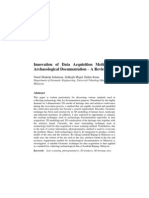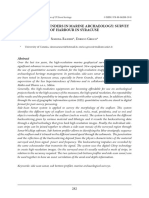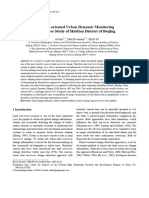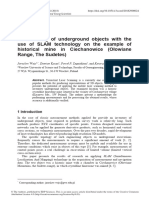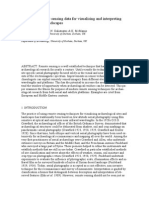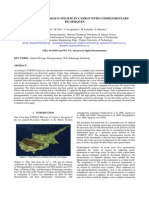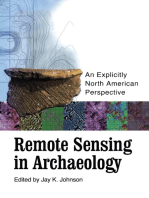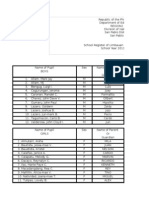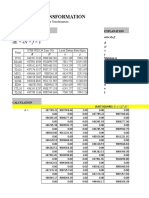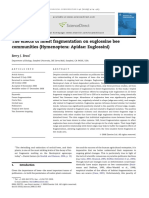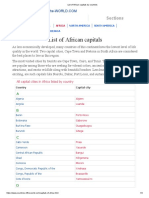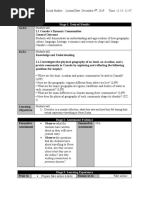276-281 Lasaponara PDF
276-281 Lasaponara PDF
Uploaded by
Erika Leon SorianoCopyright:
Available Formats
276-281 Lasaponara PDF
276-281 Lasaponara PDF
Uploaded by
Erika Leon SorianoOriginal Title
Copyright
Available Formats
Share this document
Did you find this document useful?
Is this content inappropriate?
Copyright:
Available Formats
276-281 Lasaponara PDF
276-281 Lasaponara PDF
Uploaded by
Erika Leon SorianoCopyright:
Available Formats
Proceedings of the 2
nd
Workshop of the EARSeL SIG on Land Use and Land Cover
276
SATELLITE-BASED IDENTIFICATION OF ARCHAEOLOGICAL
FEATURES
Rosa Lasaponara, Nicola Masini
Consiglio Nazionale delle Ricerche - Istituto di Metodologie per lAnalisi Ambientali
(CNR-IMAA) Tito scalo (PZ) Italy, lasaponara@imaa.cnr.it, n.masini@ibam.cnr.it
ABSTRACT
This paper deals with the use of QuickBird images for the identification of features linked to
ancient transformations the landscape induced by human activities. The investigation was
performed on Metaponto, one of the most important archaeological sites in the South of Italy.
The analysis was focused on the identification of ancient land divisions related to the Greek
colonization age. The obtained results showed that the use of QuickBird images enables the
detection of the archaeological features linked to buried remains with a high level of detail.
INTRODUCTION
The importance of applying space technology to cultural heritage and archaeological re-
search has been paid great attention worldwide, mainly because, nowadays, high resolution
satellite data such as, IKONOS (1999) and QuickBird (2001), are able to match with aerial
photogrammetric surveying images. Actually, QuickBird is the commercial satellite that pro-
vides the highest spatial resolution images from both panchromatic and multispectral sensors
with resolutions of 61-72cm and 2.44-2.88m (depending upon the off-nadir viewing angle)
respectively. Satellite QuickBird imagery could open new perspective in the field of archaeo-
logical investigations (i,ii,iii).
One of the main advantages of satellite QuickBird data compared to aerial photos, is the pos-
sibility of exploiting the multispectral properties of the data. The spectral capability coupled
with high spatial resolution can make the VHR satellite images a valuable data source for
archaeological investigation ranging from synoptic view (i.e. from landscape archaeology) to
small details (i.e. single subsurface building).
However, the high spatial resolution poses a serious challenge in the feature extraction. To
obtain maximum benefit from the recently available satellite data sources extensive re-
searches are needed to improve data analysis and tools for the extraction of spatial and
spectral information. In particular, feature extraction and analysis steps are of particular im-
portance in the field of archaeological remote sensing since buried archaeological remains as
well as traces of ancient transformation of landscape tend to induce small spatial anomalies
characterized by small spectral signals. These small spatial and spectral anomalies can be
easily obscured by stronger signals emitted by earth materials (vegetation, soil, rocks, as-
phalts, concrete).
This paper deals with the use of QuickBird images for the identification of features linked to
ancient human changes of the landscape. In particular, the object of the investigation is the
reconnaissance of ancient land divisions. The study case is located in the Metaponto territory
in the South of Italy. The analysis was focused on the land divisions related to both ancient
Greek colonization and the Roman age.
METHODS
The Quickbird -based analysis adopted for the identification of superficial anomalies is shown
in figure 1.
Center for Remote Sensing of Land Surfaces, Bonn, 28-30 September 2006
277
Both panchromatic and multispectral data were first investigated individually and then com-
bined by using a data fusion algorithm. Data fusion technique integrates the geometric detail
of a high-resolution panchromatic image and the spectral information of a low-resolution im-
age to produce a high-resolution multispectral image.
As in the previous works of the same author group, the methodological approach used for
analyzing the satellite Quickbird data is mainly based on data fusion and edge detection algo-
rithms that are applied in order to better enhance and detect the superficial anomalies. Addi-
tionally, the satellite-based analysis is here enriched by edge thresholding and thinning algo-
rithms that allow a refinement identification of the target.
1) Data fusion
Image fusion refers to the process of combining multiple images of a scene to obtain a single
composite image. The different images to be fused can come from different sensors of the
same basic type or they may come from different types of sensors. The composite image
should contain a more useful description of the scene than provided by any of the individual
source images. In the current cases under investigation, the QuickBird panchromatic and
multispectral images were fused by using a data fusion algorithm that was specifically devel-
oped for VHR satellite images (iv). This algorithm exploits a method based on least squares
for founding the best approximation between the fused image bands and the original data.
This obtains the maximum increase in detail coupled with a minimum distortion. This algo-
rithm has been adopted by Digital Globe and it is also available in a PCI-Geomatica routine.
2) Edge detection
In order to emphasize the marks arising from the presence of buried structures, an edge de-
tection algorithm was applied to data fusion products. The edge detection was performed (v)
by applying a multiscale approach based on the scale-space theory that uses Gaussian
smoothing kernels. The selection of scale was undertaken keeping in mind that, in our case it
was necessary to focus on structures having small sizes and signal amplitudes as expected
in the case of surface anomalies due to buried walls, buildings and roads.
3) Edge thresholding
In this study, histogram-based thresholding was used to produce a binary image, in that all
edge elements have value one. The threshold is not an absolute one, but an upper percent-
age from the cumulative distribution function of the edge detection filtered image.
4) Edge thinning
Thinning algorithms are used on binary images to generate skeletons that preserve the same
connectivity structures as the objects in the original images. Thinning is a pre-processing op-
eration of pattern recognition since a thinned object is easier to trace and hence is easier to
recognize. Generally, a thinning algorithm is used to erode an object, layer by layer until only
a unit-width skeleton is left.
In the present study case, the fast parallel thinning algorithm by (vi) was used. Such an algo-
rithm was selected because it preserves the merits of the original, such as the edge noise
immunity and good effect in thinning crossed lines. It also overcomes weaknesses such as
the serious shrinking and line connectivity problems. A 3x 3 pixel window size, shown in table
is used, as previously, in the edge detection step.
5) Line extraction
Using visual inspection, we only considered regular pattern anomalies because the presence
of geometric features, being quite rare in nature, generally provides useful information for the
identification of signs indicating ancient human activities.
Proceedings of the 2
nd
Workshop of the EARSeL SIG on Land Use and Land Cover
278
Finally, the last step of the adopted procedure is the reconnaissance and interpretation of
marks. This is a very important task that is performed also using additional information, such
as the traditional cartography and/or field survey etc.. This facilitates the elimination or at
least reduction of the potential coarse errors linked to the presence of road networks, bridges,
pipeline etc. that can also be detected by the edge identification procedure.
Figure 1 flow chart of the procedure adopted for the identification of archaeological marks.
RESULTS & DISCUSSION
The study area is the archaeological site of Metaponto. It is located between the Basento and
Bradano rivers, near the Ionian sea, in the Southeast of the Basilicata Region (see figure 2).
It is one of the most important archaeological areas in the South of Italy.
The several archaeological campaigns (vii, viii, ix, x, xi) stated that human presence since mid
8th century B.C. was when Metaponto was founded by Greeks coming from the Acaia re-
gion. Between the Greek colonization (700 BC-200 BC) and the Roman age (200 BC 400
AD) the territory was characterized by an intensive use of the soil as revealed by the several
rural sites that can be observed by surface surveys and excavations, and also by the pres-
ence of an extensive system of parallel land divisions. In particular, these lines are thought to
have been a network of country lanes or drainage canals. The satellite-based detection of
these land divisions is the main objective of our analysis.
The detected land divisions are close to the Archaeological Park of Metaponto that includes
(see A in figure 3a-b) four temples built between the 6th and 4th century BC, the agora
(namely market place) and a theatre dating back to the second half of the 4th century (see,
respectively 1,2 and 3 in figure 3a). The areas under investigation were mainly covered by
weeds, such as Eruca sativa, Cichorium intybus, Agropyron repens.
The satellite analysis was carried out by using QuickBird images (Catalog ID
1010010003314001) acquired on August 22nd 2004 with an off nadir view angle of 2 degrees
(see table 1).The reconnaissance of land divisions was performed by analyzing the results
obtained from the edge detection algorithm applied to both single channels and data fusion
products. The best results were obtained from panchromatic, NIR channel images, and NDVI
(obtained from the following formula: NIR-RED/NIR+RED) maps. However, the Blue, Green
and Red channels did not show any regular features of archaeological interest. The results
obtained from the edge detection algorithm applied to data fusion products substantially
Center for Remote Sensing of Land Surfaces, Bonn, 28-30 September 2006
279
Figure 2. Study area location.
agreed with those found from the NDVI and spectral channels processed at their own spatial
resolution. In this case, the main advantage of using data fusion products was the increased
spatial resolution that provided a more accurate detection of the marks.
The detected anomalies are the typical marks induced by the presence of vegetation that, in
this case, is mainly composed by weeds. Such anomalies, indicated respectively as B and C
in figure 3a-b, are evident in the east and southeast parts of the Archaeological Park. In par-
ticular, for the B area, the weed-marks related to land divisions are not visible by using the
panchromatic image. They are only delineated (see, figure 3b,d) by using NIR channel im-
ages (both single channel and NIR data fusion product). The use of NDVI map (figure 4)
makes such marks more evident. There are seven rectilinear features: six of these features
have an orientation of 55-60 West of North (that are distanced from each other by about 35
to 54 m) and one is orthogonal to them.
For the C area, the weed-marks are visible using only panchromatic and NIR images (figure 3
a-d). Here, there are 6 rectilinear features with an orientation of 50-55 West of North that
are distant each other approximately 46 to 48 m.
The fact that the same kind of archaeological mark exhibits different spectral features, can be
linked to the different surface characteristics observed for the two investigated areas. Both of
them were covered by weeds (such as Eruca sativa, Cichorium intybus, Agropyron repens ),
that were dry at the end of summer when the satellite images were acquired (August, 22nd
2004). However, area B (see Figure 3) had a more packed weed cover compared to that pre-
sent over area C. Therefore, for area B the reflectance variations induced by the presence of
buried archaeological deposits are stronger than those observed for area C. These variations
are remarkably emphasized by the NIR band and NDVI map (see figure 3b,d and 4,); thus,
showing the high potential of multispectral Quickbird data. This makes them ideal for investi-
gations on a regional scale as well as for research performed in areas where aerial photogra-
phy is restricted because of military or political reasons.
Proceedings of the 2
nd
Workshop of the EARSeL SIG on Land Use and Land Cover
280
Figure 3. QuickBird images. (a) Panchromatic image: letter A denotes the Archaeological
Park, B and C indicate the areas in which crop marks were detected; (b) NIR data fusion
product; (c) panchromatic image with survey of weed-marks related to land divisions in area
C; (d) NIR data fusion product with survey of weed-marks related to land divisions in area B
and C.
Figure 4. QuickBird NDVI map (a) and the archaeological features detected (b).
REFERENCE
i Lasaponara R and Masini N 2005 QuickBird-based analysis for the spatial characteriza-
tion of archaeological sites: case study of the Monte Serico Medioeval village Geophysi-
cal Research Letter 32 (12) L12313 10.1029/2005GL022445.
ii Lasaponara R and Masini N 2006a On the potential of Quickbird data for archaeological
prospection International Journal of Remote Sensing, in press.
Center for Remote Sensing of Land Surfaces, Bonn, 28-30 September 2006
281
iii Lasaponara R and Masini N 2006b Identification of archaeological buried remains based
on Normalized Difference Vegetation Index (NDVI) from Quickbird satellite data IEEE
Transactions on Geoscience and Remote Sensing Letters, in press.
iv Zhang Y 2004 Understanding Image Fusion Photogrammetric Engineering & Remote
Sensing 70 657-661.
v Lindeberg T 1998 Feature detection with automatic scale selection In. J. of Computer
Vision 30(2) 79116.
vi Chen Y S and Hsu W H 1988 A modified fast parallel algorithm for thinning digital pat-
terns Pattern Recognit. Lett. 7 (2) 99106.
vii Adamesteanu D 1974 La Basilicata antica. Storia e monumenti (Cava dei Tirreni).
viii Adamesteanu D 1973 Le suddivisioni di terra nel metapontino in Finley M I (Eds),
Problmes de la terre en Grce ancienne (Paris: Mouton), 49-61.
ix Carter J C 1980 Excavations in the territory of Metaponto (Austin: Institute of Classical).
x Carter J C 1983 The territory of Metaponto, 1981-82 (Austin: Institute of Classical)
xi Carter J C 1990 Between the Bradano and Basento: Archaeology of an Ancient Land-
scape in Kelso W and Most R (Eds.) Earth Patterns. Essays in Landscape Archaeology (Char-
lottesville : University of Virginia Press) 227-243.
You might also like
- PDQ# - Swashbucklers of The 7 Skies PDFDocument336 pagesPDQ# - Swashbucklers of The 7 Skies PDFTom Musco100% (1)
- GIS Past Paper ExamsDocument11 pagesGIS Past Paper ExamsShoturu100% (7)
- Declination: Conversations With KT BoehrerDocument10 pagesDeclination: Conversations With KT Boehrerfarzana25No ratings yet
- Flooding Ferny Grove Flood Flag MapDocument1 pageFlooding Ferny Grove Flood Flag MapNgaire TaylorNo ratings yet
- 202 7 Arqueo PDFDocument6 pages202 7 Arqueo PDFKobalt von KriegerischbergNo ratings yet
- Very Close Nadiral Images A Proposal For Quick Digging SurveyDocument6 pagesVery Close Nadiral Images A Proposal For Quick Digging Surveyerik costamagnaNo ratings yet
- Remote Sensing Applications in ArchaeologyDocument22 pagesRemote Sensing Applications in ArchaeologyJorge BlancasNo ratings yet
- Innovation of Data Acquisition Method in Archaeological Documentation - A ReviewDocument14 pagesInnovation of Data Acquisition Method in Archaeological Documentation - A ReviewShahida Ed SulaimanNo ratings yet
- Landsat 8: Utilizing Sensitive Response Bands Concept For Image Processing and Mapping of BasaltsDocument12 pagesLandsat 8: Utilizing Sensitive Response Bands Concept For Image Processing and Mapping of BasaltsDavid PradaNo ratings yet
- Lanari Mapping PrePrint1Document35 pagesLanari Mapping PrePrint1Aravind JkNo ratings yet
- International Journal of Applied Earth Observation and GeoinformationDocument6 pagesInternational Journal of Applied Earth Observation and Geoinformationjose_seoran_1983No ratings yet
- On The Airborne Lidar Contribution in ArDocument29 pagesOn The Airborne Lidar Contribution in ArMilijan Čombe BrankovićNo ratings yet
- Lanari Et Al., 2018. Quantitative Compositional Mapping of Mineral Phases by Electron Probe Micro-Analyser PDFDocument25 pagesLanari Et Al., 2018. Quantitative Compositional Mapping of Mineral Phases by Electron Probe Micro-Analyser PDFAndrés FabiánNo ratings yet
- Use of Echosounders in Marine Archaeolog PDFDocument6 pagesUse of Echosounders in Marine Archaeolog PDFsyahna rahmahNo ratings yet
- Automated Lineament Extraction Applied To High-Resolution Imagery Worldview-3 and LiDAR Data For Pegmatite Mineral ExplorationDocument10 pagesAutomated Lineament Extraction Applied To High-Resolution Imagery Worldview-3 and LiDAR Data For Pegmatite Mineral ExplorationDouglas SantosNo ratings yet
- Abate2019 Article DocumentationOfPaintingsRestorDocument20 pagesAbate2019 Article DocumentationOfPaintingsRestorJack HollandNo ratings yet
- Application of Remote Sensing Techniques in Basin AnalysisDocument13 pagesApplication of Remote Sensing Techniques in Basin AnalysisJaymin RathaviNo ratings yet
- Discussion 3Document2 pagesDiscussion 3ayeshashafiq1No ratings yet
- 4 - Term061 - Report - Al-ShehabDocument19 pages4 - Term061 - Report - Al-ShehabAnderson Muñoz PaezNo ratings yet
- Case Study of Haidian District of BeijingDocument7 pagesCase Study of Haidian District of Beijing22m0266No ratings yet
- Evaluating Pixel-Based Vs Object-Based Image AnalyDocument17 pagesEvaluating Pixel-Based Vs Object-Based Image AnalyAugustoSuárezNo ratings yet
- Multiparametric Approach To The Assessment of Muon Tomographic Results For The Inspection of A Full-Scale ContainerDocument20 pagesMultiparametric Approach To The Assessment of Muon Tomographic Results For The Inspection of A Full-Scale ContainerBharat SinghNo ratings yet
- 09 Kovacs Et Al PDFDocument14 pages09 Kovacs Et Al PDFAde Parid HidayatNo ratings yet
- Corona CikkENGjavitvaDocument7 pagesCorona CikkENGjavitvaIonut Alexandru CristeaNo ratings yet
- 09 Kovacs Et AlDocument14 pages09 Kovacs Et AlBenciu Florin ValentinNo ratings yet
- Drones 04 00046Document28 pagesDrones 04 00046pereiragrNo ratings yet
- Mineral Exploration Using GIS FinalDocument16 pagesMineral Exploration Using GIS FinalRicardo CesarNo ratings yet
- Influence of Geological Structures in Aiding Landslide Initiation in Chimanimani, ZimbabweDocument10 pagesInfluence of Geological Structures in Aiding Landslide Initiation in Chimanimani, ZimbabweInternational Journal of Innovative Science and Research TechnologyNo ratings yet
- Mapping of Lineaments For Groundwater Targeting Using NigeriaSat-X Satellite Data in Owo Area of Ondo State (South West of Nigeria)Document14 pagesMapping of Lineaments For Groundwater Targeting Using NigeriaSat-X Satellite Data in Owo Area of Ondo State (South West of Nigeria)aniemmanuelcNo ratings yet
- Artificial Neural Networks As A Tool For Mineral P-2Document7 pagesArtificial Neural Networks As A Tool For Mineral P-2ADELEKEADEDOYINNo ratings yet
- Research ArticleDocument12 pagesResearch ArticlelataNo ratings yet
- An Automated Technique To Determine Spatio-Temporal Changes in Satellite Island Images With Vectorization and Spatial QueriesDocument17 pagesAn Automated Technique To Determine Spatio-Temporal Changes in Satellite Island Images With Vectorization and Spatial Queriesmatrex matrexNo ratings yet
- A Research On Mineral Exploration Using GIS and Remote SensingDocument33 pagesA Research On Mineral Exploration Using GIS and Remote SensingHrishi BhardwajNo ratings yet
- 3d ModelingDocument10 pages3d Modelingkatarzyna.zagozdzonNo ratings yet
- Remote Sensing of Environment: Alexander F. H. GoetzDocument12 pagesRemote Sensing of Environment: Alexander F. H. GoetzsaurabhNo ratings yet
- Lineament Density From Satellite ImageryDocument11 pagesLineament Density From Satellite ImageryImam Muhajjir Fakhri PutraNo ratings yet
- Seismic Data Interpretation Using The Hough Transform and Principal Component AnalysisDocument14 pagesSeismic Data Interpretation Using The Hough Transform and Principal Component AnalysisDaniel OrdazNo ratings yet
- Curso Python para PrincipiantesDocument6 pagesCurso Python para PrincipiantesYanquiel Mansfarroll GonzalezNo ratings yet
- The Use of Geodetic Techniques in The DoDocument15 pagesThe Use of Geodetic Techniques in The DoFotini KalaiNo ratings yet
- Identification - and - Mapping - of - Minerals - in - Drill Core Using PIMA - Kruse - 1996 - CoDocument13 pagesIdentification - and - Mapping - of - Minerals - in - Drill Core Using PIMA - Kruse - 1996 - CoGustavoNo ratings yet
- Use of Remote Sensing Data For Archaeological LandscapesDocument10 pagesUse of Remote Sensing Data For Archaeological LandscapesZenón Rizo FernándezNo ratings yet
- Soil SensingDocument18 pagesSoil Sensing124009181No ratings yet
- GIS Lecture NotesDocument11 pagesGIS Lecture NotesFloor RoeterdinkNo ratings yet
- UACE2019 888 GourniaDocument8 pagesUACE2019 888 Gourniagermanytour9No ratings yet
- CONESCAPAN 2022 Paper 24741Document6 pagesCONESCAPAN 2022 Paper 24741HICHAM LAHMAIDINo ratings yet
- Advances in Space Research Volume 57 Issue 8 2016Document17 pagesAdvances in Space Research Volume 57 Issue 8 2016Josh ElrichNo ratings yet
- Expert Systems With Applications: Zhang Rongqun, Zhu DaolinDocument6 pagesExpert Systems With Applications: Zhang Rongqun, Zhu DaolinRenata SmithNo ratings yet
- Chap01 Cawhiv0tDocument31 pagesChap01 Cawhiv0tAndy KristiantoNo ratings yet
- Isprsannals II 5 289 2014Document7 pagesIsprsannals II 5 289 2014Iván PuenteNo ratings yet
- EtatfDocument7 pagesEtatfAstroteck Daniel EduardoNo ratings yet
- A. Remote Sensing in Geologic Surveys ApplicationsDocument6 pagesA. Remote Sensing in Geologic Surveys ApplicationsAmit KumawatNo ratings yet
- The Importanceof Considering Atmospheric Correctioninthe Preprocessing 2Document5 pagesThe Importanceof Considering Atmospheric Correctioninthe Preprocessing 2Usns AbaeNo ratings yet
- Photogrammetry and Archaeological Knowledge: Toward A 3dinformation System Dedicated To Medieval Archaeology: A Case Study of Shawbak Castle in JordanDocument8 pagesPhotogrammetry and Archaeological Knowledge: Toward A 3dinformation System Dedicated To Medieval Archaeology: A Case Study of Shawbak Castle in JordanHeidi WaintrubNo ratings yet
- _1_2015_chiba Et Al_development of Network-type Archaeological Investigation_isprsarchives-xl-5-w7!99!2015Document5 pages_1_2015_chiba Et Al_development of Network-type Archaeological Investigation_isprsarchives-xl-5-w7!99!2015Gab RibNobNo ratings yet
- A Study On Optimal D-Insar Filtering Technique According To Landform ReliefDocument10 pagesA Study On Optimal D-Insar Filtering Technique According To Landform ReliefFila MerahNo ratings yet
- Almost ThereDocument11 pagesAlmost ThererogirosNo ratings yet
- NHAZCA InSAR Feasibility ToolDocument9 pagesNHAZCA InSAR Feasibility ToolFrancisco OrdoñezNo ratings yet
- Documenting A Unesco WH Site in Cyprus With Complementary TechniquesDocument6 pagesDocumenting A Unesco WH Site in Cyprus With Complementary TechniquesAndreas GeorgopoulosNo ratings yet
- Preacher's Cave High Definition Survey and 3DLaser Scanning Project, Eleuthera, BahamasDocument12 pagesPreacher's Cave High Definition Survey and 3DLaser Scanning Project, Eleuthera, BahamasAIST - Alliance for Integrated Spatial TechnologiesNo ratings yet
- 2015 Kritikakis Seismic&ERTDocument6 pages2015 Kritikakis Seismic&ERTKamel HebbacheNo ratings yet
- 1 s2.0 S2090997713000539 MainDocument6 pages1 s2.0 S2090997713000539 MainJHON PINEDANo ratings yet
- Remote Sensing in Archaeology: An Explicitly North American PerspectiveFrom EverandRemote Sensing in Archaeology: An Explicitly North American PerspectiveNo ratings yet
- Autographic Design: The Matter of Data in a Self-Inscribing WorldFrom EverandAutographic Design: The Matter of Data in a Self-Inscribing WorldNo ratings yet
- DETERMINATIONoferodibilitystatusofsomesoilin Ikeduru LGAof Imo State NIGERIADocument9 pagesDETERMINATIONoferodibilitystatusofsomesoilin Ikeduru LGAof Imo State NIGERIAAan FebrianNo ratings yet
- Limbauan XCLDocument14 pagesLimbauan XCLBen TenNo ratings yet
- Se Asia Research Group Theses: Robert Hall Cenozoic Tectonics of Indonesia: Problems and ModelsDocument5 pagesSe Asia Research Group Theses: Robert Hall Cenozoic Tectonics of Indonesia: Problems and Modelsarie_stoner13No ratings yet
- 2D Affine Transformation: Ae + BN + C X de + en + F yDocument12 pages2D Affine Transformation: Ae + BN + C X de + en + F yMuhammad ArdianNo ratings yet
- Aspirents Forum: MPSC Mains Previous Papers Topic Wise Question (Numeric) AnalysisDocument5 pagesAspirents Forum: MPSC Mains Previous Papers Topic Wise Question (Numeric) Analysisshailesh goralNo ratings yet
- Tigertail Lagoon & Sand Dollar Island: Physical Evolution and Ecosystem Analysis (2018) - Humiston & Moore EngineersDocument68 pagesTigertail Lagoon & Sand Dollar Island: Physical Evolution and Ecosystem Analysis (2018) - Humiston & Moore EngineersOmar Rodriguez OrtizNo ratings yet
- Singapore Property Weekly Issue 287Document10 pagesSingapore Property Weekly Issue 287Propwise.sgNo ratings yet
- The Arts AnalysisDocument11 pagesThe Arts AnalysisNone None NoneNo ratings yet
- The MegalopolisDocument7 pagesThe MegalopolisnuhisterNo ratings yet
- Some Interesting Facts: African Culture HereDocument2 pagesSome Interesting Facts: African Culture HereYvonne BascoNo ratings yet
- Sci H 02506131 Project 1 ADocument2 pagesSci H 02506131 Project 1 AFreddie Leo Dollaga RiveraNo ratings yet
- 2 Erosional Development of Streams (Horton, 1945)Document96 pages2 Erosional Development of Streams (Horton, 1945)alvlaroNo ratings yet
- Trail Runners Guide ISBN 9781770263697Document9 pagesTrail Runners Guide ISBN 9781770263697MapStudio0% (2)
- (NAPA) : GEF Lesotho'S National Adaptation Programme of ActionDocument71 pages(NAPA) : GEF Lesotho'S National Adaptation Programme of ActionsaiNo ratings yet
- Holiday Homework of Class 10thDocument6 pagesHoliday Homework of Class 10thwardhanyashmishraNo ratings yet
- Typical Hydraulic CalculationsDocument22 pagesTypical Hydraulic CalculationsGaurav SinghNo ratings yet
- Activity Sheet - Ancient China IntroductionDocument4 pagesActivity Sheet - Ancient China Introductionfruittingles100% (1)
- VULNERABILITY ASSESSMENT For FLOODING in PDFDocument44 pagesVULNERABILITY ASSESSMENT For FLOODING in PDFArchAngel Grace Moreno BayangNo ratings yet
- U The Effects of Forest Fragmentation On Euglossine BeeDocument10 pagesU The Effects of Forest Fragmentation On Euglossine BeeANDREA DEL PILAR FAJARDO HENAONo ratings yet
- History of PlanningDocument28 pagesHistory of PlanningLouise Lane100% (1)
- Module 2 - Lesson 1 First Voyage Around The WorldDocument22 pagesModule 2 - Lesson 1 First Voyage Around The WorldFrance PilapilNo ratings yet
- List of African Countries CapitalsDocument4 pagesList of African Countries Capitalskhan100% (3)
- California Coastal Commission Notice Prior To Issuance of Executive Director Cease and Desist OrderDocument8 pagesCalifornia Coastal Commission Notice Prior To Issuance of Executive Director Cease and Desist OrderCouncilDistrict11No ratings yet
- Social Studies - DecDocument4 pagesSocial Studies - Decapi-476217838No ratings yet
- Reinforcement Worksheet 2: 5 Grade Social StudiesDocument2 pagesReinforcement Worksheet 2: 5 Grade Social StudiesJasmín GálvezNo ratings yet
- Stories Written in Stone Abstracts Volume Provisory July 2013 t5Document126 pagesStories Written in Stone Abstracts Volume Provisory July 2013 t5Andrada Raluca100% (1)
- Fluvial Corridor NDocument9 pagesFluvial Corridor NCristina CristeaNo ratings yet







